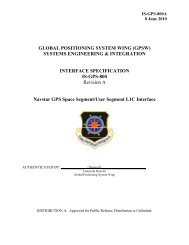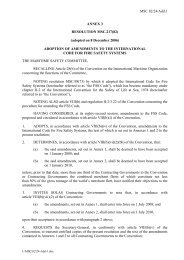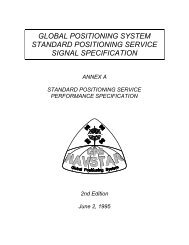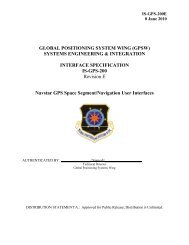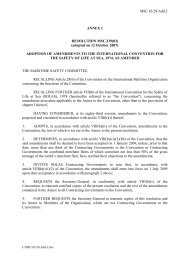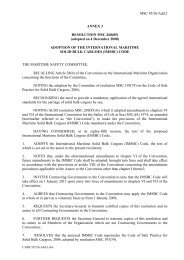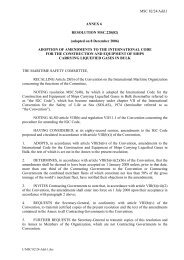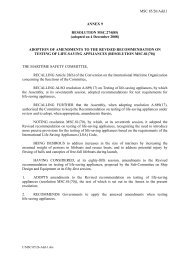The LORAN-C System - US Coast Guard Navigation Center
The LORAN-C System - US Coast Guard Navigation Center
The LORAN-C System - US Coast Guard Navigation Center
You also want an ePaper? Increase the reach of your titles
YUMPU automatically turns print PDFs into web optimized ePapers that Google loves.
circle containing the baseline (i.e., on the extension of the baselinebeyond the two stations joined) are part of what is termed the baselineextension. As noted below, navigational use of a particular mastersecondarypair in the area of the baseline extension is problematic.(Baseline extensions are shown on nautical charts, as discussed inChapter VI.)Key technical terms defined in this section include GRI, ED, CD,baseline, baseline travel time, and baseline extension.Hyperbolic <strong>System</strong>s: A Second LookAs noted in Chapter I, hyperbolic navigation systems function bymeasuring the time differences in reception of signals from the masterand secondary transmitters. This chapter expands upon the basic idea ofthe hyperbolic system with particular emphasis on the Loran-C system.This section is fairly technical, and may be skipped by the readeruninterested in such detail. Overall, the key technical points aresimple enough. First, the locus of points of constant difference indistance from two stations is described by a mathematical functiontermed a hyperbola. Second, the same is true for time differences(assuming a constant propagation velocity). <strong>The</strong>refore, LOPs of constantTDs are likewise hyperbolas. Finally, the real world is slightly morecomplex than the assumption of a constant propagation velocity wouldindicate. Precise calculations of the physical location of loran LOPsrequire a series of correction factors to be applied to account for thefact that loran waves slow down over seawater or land (compared topropagation through the atmosphere).Hyperbolic Geometry On a PlaneTo be concrete, suppose that (as some ancients did) the earth were aflat plane, defined by the usual rectangular (X, Y) coordinate system,where the units of the X and Y axis are in nautical miles from anorigin located at the point (0,0). Now suppose that two loran stationsare located on this lattice, a master station located at the pointM=(Xm, Ym) = (-200, 0) along the X-axis, and an X-ray secondary stationat the point S = (Xs, Ys) (200, 0)-some 400 NM to the right along theX-axis. Consider an arbitrary point A = (Xa, Ya) on the lattice. Fromelementary plane geometry, the distance (in nautical miles) from pointA to the master M, denoted d am , is:d am = ((Xa - Xm) 2 + (Ya - Ym) 2 ), 0.5 (II-1)Or, in terms of the defined location of the master station, equation(II_1) reduces to:d am = ((Xa + 200) 2 + Y 2 a). 0.5 (II-2)Likewise, the distance from point A to the secondary, denoted d as , isgiven by:d as = ((x a -200) 2 + y 2 a). 0.5 (II-3)Finally, the difference between these distances, denoted Z, is givenby:





